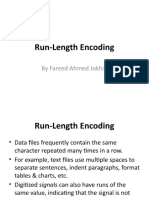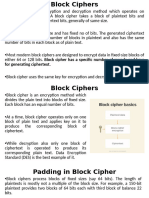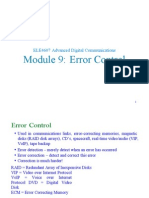0 ratings0% found this document useful (0 votes)
69 viewsLecture 13 - Delta Coding
Delta encoding stores data as the difference between successive samples rather than storing the samples directly. It works best for smooth data where adjacent values are typically close. The first value is stored normally, and subsequent values are the difference from the previous value. This shifts the data toward zero, enabling further compression with techniques like Huffman encoding that work best on data probabilities centered around zero. Linear predictive coding expands on this idea to better predict each value based on multiple previous samples.
Uploaded by
Tanveer Ahmed HakroCopyright
© © All Rights Reserved
Available Formats
Download as PPTX, PDF, TXT or read online on Scribd
0 ratings0% found this document useful (0 votes)
69 viewsLecture 13 - Delta Coding
Delta encoding stores data as the difference between successive samples rather than storing the samples directly. It works best for smooth data where adjacent values are typically close. The first value is stored normally, and subsequent values are the difference from the previous value. This shifts the data toward zero, enabling further compression with techniques like Huffman encoding that work best on data probabilities centered around zero. Linear predictive coding expands on this idea to better predict each value based on multiple previous samples.
Uploaded by
Tanveer Ahmed HakroCopyright
© © All Rights Reserved
Available Formats
Download as PPTX, PDF, TXT or read online on Scribd
You are on page 1/ 41
Delta Encoding
By Fareed Ahmed Jokhio
Delta Encoding
• In science, engineering, and mathematics, the Greek
letter delta (Δ) is used to denote the change in a
variable.
• The term delta encoding, refers to several
techniques that store data as the difference between
successive samples (or characters), rather than
directly storing the samples themselves.
• Figure on next slide shows an example of how this is
done.
Delta Encoding
• The first value in the delta encoded file is the
same as the first value in the original data.
• All the following values in the encoded file are
equal to the difference (delta) between the
corresponding value in the input file, and
the previous value in the input file.
Delta Encoding
• Delta encoding can be used for data
compression when the values in the original
data are smooth, that is, there is typically only
a small change between adjacent values.
• This is not the case for ASCII text and
executable code; however, it is very common
when the file represents a signal.
Delta Encoding
• For instance, Fig. shows a segment of an audio
signal, digitized to 8 bits, with each sample
between -127 and 127.
Delta Encoding
• Figure on this slide shows the delta encoded
version of this signal.
Delta Encoding
• The key feature is that the delta encoded signal
has a lower amplitude than the original signal.
• In other words, delta encoding has increased
the probability that each sample's value will be
near zero, and decreased the probability that it
will be far from zero.
• This uneven probability is just the thing that
Huffman encoding needs to operate.
Delta Encoding
• If the original signal is not changing, or is
changing in a straight line, delta encoding will
result in runs of samples having the same
value.
• This is what run-length encoding requires.
• Correspondingly, delta encoding followed by
Huffman and/or run-length encoding is a
common strategy for compressing signals.
Delta Encoding
• The idea used in delta encoding can be
expanded into a more complicated technique
called Linear Predictive Coding, or LPC.
• To understand LPC, imagine that the first 99
samples from the input signal have been
encoded, and we are about to work on sample
number 100.
Delta Encoding
• We then ask ourselves: based on the first 99
samples, what is the most likely value for
sample 100?
• In delta encoding, the answer is that the most
likely value for sample 100 is the same as the
previous value, sample 99.
• This expected value is used as a reference to
encode sample 100.
Delta Encoding
• That is, the difference between the sample and
the expectation is placed in the encoded file.
• LPC expands on this by making a better guess at
what the most probable value is.
• This is done by looking at the last several
samples, rather than just the last sample.
• The algorithms used by LPC are similar to
recursive filters, making use of the z-transform
and other intensively mathematical techniques.
Lempel–Ziv–Welch (LZW) Algorithm
• Left to right: Abraham Lempel, Jacob Ziv &
Terry Welch
Lempel–Ziv–Welch (LZW) Algorithm
• The LZW algorithm is a very common
compression technique.
• This algorithm is typically used in GIF and
optionally in PDF and TIFF.
• Unix’s ‘compress’ command, among other
uses.
• It is lossless, meaning no data is lost when
compressing.
Lempel–Ziv–Welch (LZW) Algorithm
• The algorithm is simple to implement and has
the potential for very high throughput in
hardware implementations.
• It is the algorithm of the widely used Unix file
compression utility compress, and is used in
the GIF image format.
Lempel–Ziv–Welch (LZW) Algorithm
• The Idea relies on reoccurring patterns to save
data space.
• LZW is the foremost technique for general
purpose data compression due to its simplicity
and versatility.
• It is the basis of many PC utilities that claim to
“double the capacity of your hard drive”.
Lempel–Ziv–Welch (LZW) Algorithm
• LZW compression works by reading a
sequence of symbols, grouping the symbols
into strings, and converting the strings into
codes.
• Because the codes take up less space than the
strings they replace, we get compression.
• Characteristic features of LZW includes:
Lempel–Ziv–Welch (LZW) Algorithm
• LZW compression uses a code table, with 4096
as a common choice for the number of table
entries.
• Codes 0-255 in the code table are always
assigned to represent single bytes from the
input file.
Lempel–Ziv–Welch (LZW) Algorithm
• When encoding begins the code table contains
only the first 256 entries, with the remainder
of the table being blanks.
• Compression is achieved by using codes 256
through 4095 to represent sequences of
bytes.
Lempel–Ziv–Welch (LZW) Algorithm
• As the encoding continues, LZW identifies
repeated sequences in the data, and adds
them to the code table.
• Decoding is achieved by taking each code from
the compressed file and translating it through
the code table to find what character or
characters it represents.
Lempel–Ziv–Welch (LZW) Algorithm
• Example: ASCII code.
• Typically, every character is stored with 8 binary
bits, allowing up to 256 unique symbols for the
data.
• This algorithm tries to extend the library to 9 to
12 bits per character.
• The new unique symbols are made up of
combinations of symbols that occurred
previously in the string.
Lempel–Ziv–Welch (LZW) Algorithm
• It does not always compress well, especially
with short, diverse strings.
• But is good for compressing redundant data,
and does not have to save the new dictionary
with the data: this method can both compress
and uncompress data.
Lempel–Ziv–Welch (LZW) Algorithm
• The idea of the compression algorithm is the
following: as the input data is being processed, a
dictionary keeps a correspondence between the
longest encountered words and a list of code values.
• The words are replaced by their corresponding
codes and so the input file is compressed.
• Therefore, the efficiency of the algorithm increases
as the number of long, repetitive words in the input
data increases.
LZW ENCODING
Compression using LZW
• Example 1: Use the LZW algorithm to
compress the string: BABAABAAA
• The steps involved are systematically shown in
the diagram below.
Compression using LZW
Compression using LZW
Compression using LZW
Compression using LZW
Compression using LZW
Compression using LZW
LZW Decompression
• The LZW decompressor creates the same string
table during decompression.
• It starts with the first 256 table entries initialized
to single characters.
• The string table is updated for each character in
the input stream, except the first one.
• Decoding achieved by reading codes and
translating them through the code table being
built.
LZW Decompression Algorithm
LZW Decompression
• Example 2: LZW Decompression: Use LZW to
decompress the output sequence
of : <66><65><256><257><65><260>
• The steps involved are systematically shown in
the diagram below.
LZW Decompression
• In this example, 72 bits are represented with
72 bits of data.
• After a reasonable string table is built,
compression improves dramatically.
LZW Summary:
• This algorithm compresses repetitive
sequences of data very well.
• Since the codewords are 12 bits, any single
encoded character will expand the data size
rather than reduce it.
Advantages of LZW over Huffman:
• LZW requires no prior information about the
input data stream.
• LZW can compress the input stream in one
single pass.
• Another advantage of LZW its simplicity,
allowing fast execution.
You might also like
- Design and Implementation Af LZW Data Compression AlgorithmNo ratings yetDesign and Implementation Af LZW Data Compression Algorithm11 pages
- Verilog Session: General Introduction To Verilog HDL: EE282 Spring Quarter, 2001-2002No ratings yetVerilog Session: General Introduction To Verilog HDL: EE282 Spring Quarter, 2001-200211 pages
- LZW Compression and Decompression: December 4, 2015No ratings yetLZW Compression and Decompression: December 4, 20157 pages
- Dictionary Techniques (Lempel-Ziv Codes) : Dictionary, and Encode These Patterns by TransmittingNo ratings yetDictionary Techniques (Lempel-Ziv Codes) : Dictionary, and Encode These Patterns by Transmitting26 pages
- Module 5 - Info Theory and Compression AlgoNo ratings yetModule 5 - Info Theory and Compression Algo58 pages
- Main Techniques and Performance of Each CompressionNo ratings yetMain Techniques and Performance of Each Compression23 pages
- Compression: Some Slides Courtesy James Allan@umassNo ratings yetCompression: Some Slides Courtesy James Allan@umass47 pages
- Fundamentals of Compression: Prepared By: Haval AkrawiNo ratings yetFundamentals of Compression: Prepared By: Haval Akrawi21 pages
- Cryptography Week4 Assessment: KEY: 0123456789ABCDEF Input Data: Hi Hello WelcomeNo ratings yetCryptography Week4 Assessment: KEY: 0123456789ABCDEF Input Data: Hi Hello Welcome7 pages
- Lecture 2 - Traditional Symmetric CryptographyNo ratings yetLecture 2 - Traditional Symmetric Cryptography46 pages
- Unit 2 - Part 7 Coding Information Sources: 1 Adaptive Variable-Length CodesNo ratings yetUnit 2 - Part 7 Coding Information Sources: 1 Adaptive Variable-Length Codes5 pages
- Microprocessor - 8085 Internal ArchitectureNo ratings yetMicroprocessor - 8085 Internal Architecture25 pages
- Microprocessor - Writing A Assembly ProgramNo ratings yetMicroprocessor - Writing A Assembly Program22 pages
- Microprocessor - Semi Conductior MemoryNo ratings yetMicroprocessor - Semi Conductior Memory38 pages
- Microprocessor - Mircroprocessor ConceptsNo ratings yetMicroprocessor - Mircroprocessor Concepts16 pages
- Microprocessor - Introduction To Basic MicroprocessorNo ratings yetMicroprocessor - Introduction To Basic Microprocessor21 pages
- CH#8 - Introduction To Software DevelopmentNo ratings yetCH#8 - Introduction To Software Development24 pages
- Unit#5 - Selecting & Constructing Data CollectionNo ratings yetUnit#5 - Selecting & Constructing Data Collection62 pages
- Unit#8 - Top - Most Popular DS AlgorithmsNo ratings yetUnit#8 - Top - Most Popular DS Algorithms11 pages
- Lecture 1 - Introduction To Multimedia TechnologiesNo ratings yetLecture 1 - Introduction To Multimedia Technologies37 pages
- Lecture 2 - Types of Multimedia and ConceptsNo ratings yetLecture 2 - Types of Multimedia and Concepts36 pages
- PDF Ascii Code The Extended Ascii Table CompressNo ratings yetPDF Ascii Code The Extended Ascii Table Compress6 pages
- ECE4001-Digital Communication System: Text BookNo ratings yetECE4001-Digital Communication System: Text Book51 pages
- Exit (Extrinsic Information Transfer) Chart Analysis For BCH (Bose-Chaudhuri-Hocquenghem) CodesNo ratings yetExit (Extrinsic Information Transfer) Chart Analysis For BCH (Bose-Chaudhuri-Hocquenghem) Codes7 pages
- Mathematics As A Tool: Coding Theory: Math & Physics DepartmentNo ratings yetMathematics As A Tool: Coding Theory: Math & Physics Department28 pages
- Wireless Channel Coding Techniques ECE DSNo ratings yetWireless Channel Coding Techniques ECE DS2 pages
- FIKAYI Harmo Augustin TSHOMBE IBANDA & Jonathan MWAMBANo ratings yetFIKAYI Harmo Augustin TSHOMBE IBANDA & Jonathan MWAMBA11 pages
- Image Compression Using Discrete Cosine Transform and Adaptive Huffman CodingNo ratings yetImage Compression Using Discrete Cosine Transform and Adaptive Huffman Coding5 pages
- Information Theory and Coding: Coding For Discrete Memoryless SourcesNo ratings yetInformation Theory and Coding: Coding For Discrete Memoryless Sources10 pages
- Review On VHDL Based Design of Convolutional Encoder Using Vedic Mathematics and Viterbi Decoder Using Parallel Processing Ijariie1637No ratings yetReview On VHDL Based Design of Convolutional Encoder Using Vedic Mathematics and Viterbi Decoder Using Parallel Processing Ijariie16374 pages
- Design and Implementation Af LZW Data Compression AlgorithmDesign and Implementation Af LZW Data Compression Algorithm
- Verilog Session: General Introduction To Verilog HDL: EE282 Spring Quarter, 2001-2002Verilog Session: General Introduction To Verilog HDL: EE282 Spring Quarter, 2001-2002
- LZW Compression and Decompression: December 4, 2015LZW Compression and Decompression: December 4, 2015
- Dictionary Techniques (Lempel-Ziv Codes) : Dictionary, and Encode These Patterns by TransmittingDictionary Techniques (Lempel-Ziv Codes) : Dictionary, and Encode These Patterns by Transmitting
- Main Techniques and Performance of Each CompressionMain Techniques and Performance of Each Compression
- Compression: Some Slides Courtesy James Allan@umassCompression: Some Slides Courtesy James Allan@umass
- Fundamentals of Compression: Prepared By: Haval AkrawiFundamentals of Compression: Prepared By: Haval Akrawi
- Cryptography Week4 Assessment: KEY: 0123456789ABCDEF Input Data: Hi Hello WelcomeCryptography Week4 Assessment: KEY: 0123456789ABCDEF Input Data: Hi Hello Welcome
- Unit 2 - Part 7 Coding Information Sources: 1 Adaptive Variable-Length CodesUnit 2 - Part 7 Coding Information Sources: 1 Adaptive Variable-Length Codes
- Application and Implementation of DES Algorithm Based on FPGAFrom EverandApplication and Implementation of DES Algorithm Based on FPGA
- EC Cryptography Tutorials - Herong's Tutorial ExamplesFrom EverandEC Cryptography Tutorials - Herong's Tutorial Examples
- Microprocessor - Introduction To Basic MicroprocessorMicroprocessor - Introduction To Basic Microprocessor
- Lecture 1 - Introduction To Multimedia TechnologiesLecture 1 - Introduction To Multimedia Technologies
- Exit (Extrinsic Information Transfer) Chart Analysis For BCH (Bose-Chaudhuri-Hocquenghem) CodesExit (Extrinsic Information Transfer) Chart Analysis For BCH (Bose-Chaudhuri-Hocquenghem) Codes
- Mathematics As A Tool: Coding Theory: Math & Physics DepartmentMathematics As A Tool: Coding Theory: Math & Physics Department
- FIKAYI Harmo Augustin TSHOMBE IBANDA & Jonathan MWAMBAFIKAYI Harmo Augustin TSHOMBE IBANDA & Jonathan MWAMBA
- Image Compression Using Discrete Cosine Transform and Adaptive Huffman CodingImage Compression Using Discrete Cosine Transform and Adaptive Huffman Coding
- Information Theory and Coding: Coding For Discrete Memoryless SourcesInformation Theory and Coding: Coding For Discrete Memoryless Sources
- Review On VHDL Based Design of Convolutional Encoder Using Vedic Mathematics and Viterbi Decoder Using Parallel Processing Ijariie1637Review On VHDL Based Design of Convolutional Encoder Using Vedic Mathematics and Viterbi Decoder Using Parallel Processing Ijariie1637




















































































































